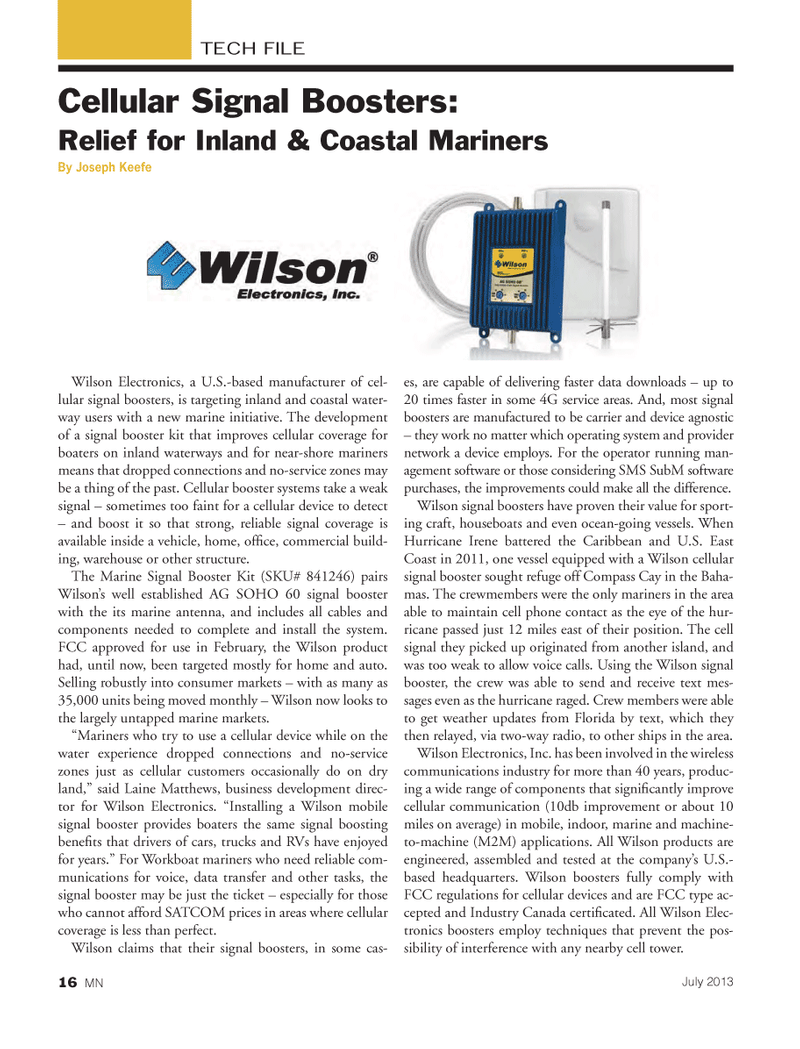
Page 16: of Marine News Magazine (July 2013)
Propulsion Technology
Read this page in Pdf, Flash or Html5 edition of July 2013 Marine News Magazine
TECH FILEWilson Electronics, a U.S.-based manufacturer of cel- lular signal boosters, is targeting inland and coastal water-way users with a new marine initiative. The development of a signal booster kit that improves cellular coverage for boaters on inland waterways and for near-shore mariners means that dropped connections and no-service zones may be a thing of the past. Cellular booster systems take a weak signal ? sometimes too faint for a cellular device to detect ? and boost it so that strong, reliable signal coverage is available inside a vehicle, home, of? ce, commercial build- ing, warehouse or other structure. The Marine Signal Booster Kit (SKU# 841246) pairs Wilsons well established AG SOHO 60 signal booster with the its marine antenna, and includes all cables and components needed to complete and install the system. FCC approved for use in February, the Wilson product had, until now, been targeted mostly for home and auto. Selling robustly into consumer markets ? with as many as 35,000 units being moved monthly ? Wilson now looks to the largely untapped marine markets. Mariners who try to use a cellular device while on the water experience dropped connections and no-service zones just as cellular customers occasionally do on dry land,? said Laine Matthews, business development direc- tor for Wilson Electronics. Installing a Wilson mobile signal booster provides boaters the same signal boosting bene? ts that drivers of cars, trucks and RVs have enjoyed for years.? For Workboat mariners who need reliable com- munications for voice, data transfer and other tasks, the signal booster may be just the ticket ? especially for those who cannot afford SATCOM prices in areas where cellular coverage is less than perfect. Wilson claims that their signal boosters, in some cas- es, are capable of delivering faster data downloads ? up to 20 times faster in some 4G service areas. And, most signal boosters are manufactured to be carrier and device agnostic ? they work no matter which operating system and provider network a device employs. For the operator running man- agement software or those considering SMS SubM software purchases, the improvements could make all the difference. Wilson signal boosters have proven their value for sport- ing craft, houseboats and even ocean-going vessels. When Hurricane Irene battered the Caribbean and U.S. East Coast in 2011, one vessel equipped with a Wilson cellular signal booster sought refuge off Compass Cay in the Baha- mas. The crewmembers were the only mariners in the area able to maintain cell phone contact as the eye of the hur- ricane passed just 12 miles east of their position. The cell signal they picked up originated from another island, and was too weak to allow voice calls. Using the Wilson signal booster, the crew was able to send and receive text mes- sages even as the hurricane raged. Crew members were able to get weather updates from Florida by text, which they then relayed, via two-way radio, to other ships in the area. Wilson Electronics, Inc. has been involved in the wireless communications industry for more than 40 years, produc- ing a wide range of components that signi? cantly improve cellular communication (10db improvement or about 10 miles on average) in mobile, indoor, marine and machine- to-machine (M2M) applications. All Wilson products are engineered, assembled and tested at the companys U.S.- based headquarters. Wilson boosters fully comply with FCC regulations for cellular devices and are FCC type ac- cepted and Industry Canada certi? cated. All Wilson Elec- tronics boosters employ techniques that prevent the pos- sibility of interference with any nearby cell tower. Cellular Signal Boosters: Relief for Inland & Coastal Mariners By Joseph KeefeJuly 201316 MNMN July2013 Layout 1-17.indd 166/28/2013 9:51:26 AM

 15
15

 17
17
